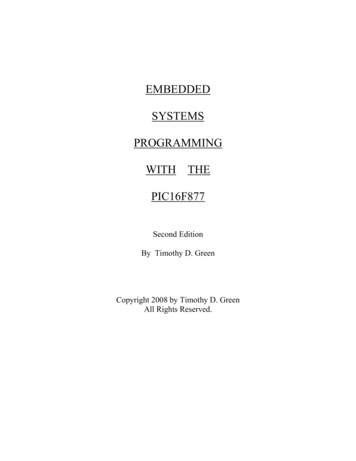
Transcription
Licensed to: CengageBrain User
Licensed to: CengageBrain UserThis is an electronic version of the print textbook. Due to electronic rights restrictions,some third party content may be suppressed. Editorial review has deemed that any suppressedcontent does not materially affect the overall learning experience. The publisher reserves the rightto remove content from this title at any time if subsequent rights restrictions require it. Forvaluable information on pricing, previous editions, changes to current editions, and alternateformats, please visit www.cengage.com/highered to search by ISBN#, author, title, or keyword formaterials in your areas of interest.Copyright 201 Cengage Learning. All Rights Reserved. May not be copied, scanned, or duplicated, in whole or in part. Due to electronic rights,some third party content may be suppressed from the eBook and/or eChapter(s). Editorial review has deemed that any suppressed content does not materiallyaffect the overall learning experience. Cengage Learning reserves the right to remove additional content at any time if subsequent rights restrictions require it.
Licensed to: CengageBrain UserSerial Murderers and TheirVictims, Sixth EditionEric W. HickeyPublisher: Linda GansterSenior Acquisitions Editor:Carolyn Henderson MeierDevelopmental Editor:Rachel McDonaldAssistant Editor:Virginette AcacioEditorial Assistant:Casey LozierMedia Editor: Andy YapMarketing Manager:Michelle WilliamsMarketing Assistant/Associate:Jack WardMarketing CommunicationsManager: Heather BaxleyArt and Cover Direction,Production Management, andComposition: PreMediaGlobalManufacturing Planner:Judy InouyeRights Acquisitions Specialist:Roberta BroyerCover Designer: RiezebosHolzbaur/Yenny YuliannyCover Image: ULKASTUDIO/Shutterstock 2013, 2010 Wadsworth, Cengage LearningALL RIGHTS RESERVED. No part of this work covered by thecopyright herein may be reproduced, transmitted, stored, or usedin any form or by any means graphic, electronic, or mechanical,including but not limited to photocopying, recording, scanning,digitizing, taping, Web distribution, information networks, orinformation storage and retrieval systems, except as permittedunder Section 107 or 108 of the 1976 United States Copyright Act,without the prior written permission of the publisher.For product information andtechnology assistance, contact us at Cengage LearningCustomer & Sales Support, 1-800-354-9706.For permission to use material from this text or product,submit all requests online at www.cengage.com/permissions.Further permissions questions can be e-mailed topermissionrequest@cengage.com.Library of Congress Control Number: 2012936020ISBN-13: 978-1-133-04970-8ISBN-10: 1-133-04970-2Wadsworth20 Davis DriveBelmont, CA 94002-3098USACengage Learning is a leading provider of customized learningsolutions with office locations around the globe, includingSingapore, the United Kingdom, Australia, Mexico, Brazil, andJapan. Locate your local office at www.cengage.com/global.Cengage Learning products are represented in Canadaby Nelson Education, Ltd.To learn more about Wadsworth, visitwww.cengage.com/wadsworthPurchase any of our products at your local college store or at ourpreferred online store www.cengagebrain.com.Printed in the United States of America1 2 3 4 5 6 7 16 15 14 13 12Copyright 201 Cengage Learning. All Rights Reserved. May not be copied, scanned, or duplicated, in whole or in part. Due to electronic rights,some third party content may be suppressed from the eBook and/or eChapter(s). Editorial review has deemed that any suppressed content does not materiallyaffect the overall learning experience. Cengage Learning reserves the right to remove additional content at any time if subsequent rights restrictions require it.
Licensed to: CengageBrain User1IntroductionLEARNING OBJECTIVES To understand the many myths surrounding the phenomenon of serialmurder and how society perpetuates those myths To explore the definition of homicide and the various classifications ofmurder in American society To explore the extent of mass and serial murder in the United States To examine the definitions and differences between mass andserial murder To evaluate case studies of mass and serial murder as they relate to thereality and frequency of multiple homicide in modern societyTHE PHENOMENON OF SERIAL MURDERMultiple murder is undoubtedly one of the most terrifying and fascinatingphenomena of modern-day crime. We are frequently reminded of how vulnerable we can be when persons who decide to kill us can do so with relative ease.No one ever imagined a military psychiatrist going on a shooting rampage atFort Hood, Texas, in 2009, killing 13 military personnel and wounding manyothers; a female college professor in 2010 in Alabama shooting six members ofher department; a college student in 2011 in Arizona walking into a grocerystore and shooting to death six people and seriously wounding many others,including a congresswoman; or a man walking into an IHOP restaurant inNevada and shooting several people before ending his own life. As of 2011,investigators in Long Island, New York, have unearthed or located in woodedareas ten victims believed to be those of a serial killer. Other serial killersinclude the Craigslist Ripper or Gilgo Killer Joel Rifkin, an unemployed landscaper who confessed to murdering 17 prostitutes; and Robert Shulman,1Copyright 201 Cengage Learning. All Rights Reserved. May not be copied, scanned, or duplicated, in whole or in part. Due to electronic rights,some third party content may be suppressed from the eBook and/or eChapter(s). Editorial review has deemed that any suppressed content does not materiallyaffect the overall learning experience. Cengage Learning reserves the right to remove additional content at any time if subsequent rights restrictions require it.
Licensed to: CengageBrain User2CHAPTER1responsible for the deaths of 5 other prostitutes. Multiple murder is one of themost sensationalized areas of research within the fields of criminology, psychology, and sociology. Getting down to the “real facts” of a case rather than getting caught up in the inevitable media barrage has become a task difficult foreven the most stringent, reputable researchers. The problems are many andinterrelated. Philip Jenkins (1994), in his book Using Murder: The Social Construction of Serial Homicide, provides a scholarly examination of how serial killinghas been dealt with by the media, law enforcement personnel, and the public.Indeed, much of what we know, or claim to know, about serial murder isbased on misinformation and myth construction. Nearly 20 years later manyof those misperceptions continue, fueled by our interest in forensics and violentcrime. One of the primary confounding myths of serial murder is that they areall, by definition, sexual. Schlesinger (2004) in his seminal work, Sexual Murder,notes that many seemingly sexual murders are not sexually motivated and thatmany sexual homicides are not overtly sexual (pp. 2–6). As a result of the sensational nature of this form of murder, the aura surrounding it has assumed alife of its own as it filters throughout both the public and private sectors ofsociety.SERIAL MURDER: FACT AND FICTIONIn the summer of 1981 in Atlanta, Georgia, Wayne Williams, a young AfricanAmerican male, was arrested for his involvement in multiple homicides ofyoung African American males. He was believed, at that time, to be one ofthe nation’s more prolific serial killers. This case brought increased focus onserial murder and the fact that not all serial killers are white, nor are thevictims, and even children could be targets. Technology, specifically hairfiber evidence, became a critical factor in convicting Williams, and forensicscience became prominent in explaining why such evidence ultimately playeda key role in linking Williams to the crimes. Over 20 homicides were attributed to Williams, most of them children, although he was actually convictedof murdering just two of his victims. The horror and fascination of this casefocused media attention on Atlanta both during the homicides and afterWilliams’s capture. Within the next three years several more accounts of serialmurder appeared in newspapers around the country. The American public hadbeen invaded by a new criminal type, the serial murderer. Lurking in ourcommunities, preying on hapless victims, serial murderers had suddenlyemerged from the criminal underground—perhaps a product of the VietnamWar or possibly a by-product of technology and the moral decay of our society. In the past, most citizens simply assumed serial killers must be insane. Noone knew for sure. But as the cases of serial murder increased, as did the bodycounts, the ever-growing reality of multiple murders began to intrude onpublic awareness. Something had to be done to stem the tide of homicideswith no apparent motive.Copyright 201 Cengage Learning. All Rights Reserved. May not be copied, scanned, or duplicated, in whole or in part. Due to electronic rights,some third party content may be suppressed from the eBook and/or eChapter(s). Editorial review has deemed that any suppressed content does not materiallyaffect the overall learning experience. Cengage Learning reserves the right to remove additional content at any time if subsequent rights restrictions require it.
Licensed to: CengageBrain UserINTRODUCTION3In 1984 the Federal Bureau of Investigation (FBI; 1984a, 1984b; NinetyEighth Congress, 1984) appeared before the U.S. Senate to seek funding forthe development of a program specifically targeting violent criminals.According to news accounts of the hearing, as many as 5,000 people peryear were believed to be killed by serial murderers. Although this was factuallynot true, the numbers used to describe the victims in all categories of violentcrime were, nonetheless, shocking and incredible. The public and public officialsalike were horrified, and funding was procured for the program. For the nextseveral years the incidence of serial murder was considered by the public to bepervasive in our society, though in fact this remained far from the truth. Noone knew how many serial killers actually existed at any one time, but it wasclear that the number of victims killed by such offenders did not even begin toapproach 5,000. Where that inflated figure first originated is still a mystery.Perhaps a piece of information exchanged during an interview between themedia and law enforcement personnel had been misinterpreted. What is important is not who started the rumors but that they were so quickly disseminatedwithout ever being verified.Such forms of disinformation are not new or uncommon. For example,when marijuana came into public view during the 1940s, a film, Reefer Madness,was distributed, depicting the powerfully destructive forces of the illegal substance.Clean, upstanding young men and women, on experiencing the effects of justone reefer, were transformed into raving, sex-crazed lunatics. Though amusingto us now, such exaggeration is disturbing in light of the film’s original purposeand effects.Much of the proliferation of disinformation is a result of public pressure toknow more about a specific subject. In some respects, a symbiotic relationshiphas developed among law enforcement personnel, the media, and the public thatserves, in fact, to encourage disinformation in regard to certain types of issues.Realizing this, some researchers, such as Philip Jenkins and others, began questioning the actual extent of serial murder. We do not question that serial murderoccurs, but to what quantifiable and qualitative extent? This is the role of the socialscientist: to objectively examine phenomena to determine their origin, nature, andimpact on society.Members of the community also want to understand the phenomnenonof serial murder. A very popular and interesting radio program Behind the YellowTape, founded by Joey Ortega, can be found on www.blogtalkradio.com/behindthetellowtape as well as their companion blog www.behindtheyellowtape.wordpress.com. National and international forensic experts discuss investigativetechniques, criminal psychology, current research in behavioral analysis, violentcrimes, profiling, victimology and other relevant topics. Ortega is also theco-founder of the Ullemeyer group, a company that offers forensic and investigative services, training in forensic disciplines, investigative specialties andcrime scene investigations to both private and public agencies. Their company,located in Santa Barbara, California can be found online at www.ullemeyer.com. Nadia Fezzani, an investigative journalist in Montreal, Canada, herself avictim of violent crime, decided to interview serial killers and publish herCopyright 201 Cengage Learning. All Rights Reserved. May not be copied, scanned, or duplicated, in whole or in part. Due to electronic rights,some third party content may be suppressed from the eBook and/or eChapter(s). Editorial review has deemed that any suppressed content does not materiallyaffect the overall learning experience. Cengage Learning reserves the right to remove additional content at any time if subsequent rights restrictions require it.
Licensed to: CengageBrain User4CHAPTER1findings. Her compelling book, My Serial Killers, (2011) documents the face toface interviews she conducted with these men. The apparent or perceivedincrease in the modern serial, or multiple, murder has incited interest amongsocial scientists in several areas. Researchers have begun to explore the social,psychological, and biological makeup of the offenders in order to establishaccurate profiles. In spite of their efforts, during the 1980s the body of knowledge about serial murders remained small compared to the number of unanswered questions—especially concerning the extent of the phenomenon. Inmore recent years law enforcement personnel and academicians have come closerto understanding the dynamics of serial killing and its etiology, or causation.The pure sensationalism and horror of serial murder have also spawned aplethora of novels about such murders, and the figure of the cold-bloodedand senseless serial killer has been exploited by the media: for example, intelevision documentaries and prime-time shows—such as those that depictedCalifornia’s Hillside Strangler, the BTK Strangler case, and the infamousTed Bundy (The Deliberate Stranger)—and in various box-office thrillers.Because of the wide publicity given to serial murderers, a stereotype of thistype of killer has formed in the mind of American society. The offender isthought of as a ruthless, bloodthirsty sex monster who lives a Jekyll-and-Hydeexistence—probably next door to you. Increasingly, crime novels and movieshave focused on multiple-homicide offenders. Consider the steady proliferation ofmultiple-homicide films in which serial killing occurs (see Table 1.1).Although the list in Table 1.1 is not exhaustive, it is representative of eachdecade. It does not include films involving mass murder (the killing of a numberof people all at one time) or horror films depicting vampires and murderouszombies, but only films portraying real people murdering other people. Noticethe explosion of serial-murder themes between the early 1990s and 2008. Morethan half of those never made it to theaters but went straight to home-videorelease. In the privacy of one’s home, viewers are bombarded with graphicT A B L E 1.1Increase in Films with Serial Killing, 1920–2008Number of SerialMurder–Themed 980s231990s150þ2000s300þþSOURCE: Cengage Learning, 2013.Copyright 201 Cengage Learning. All Rights Reserved. May not be copied, scanned, or duplicated, in whole or in part. Due to electronic rights,some third party content may be suppressed from the eBook and/or eChapter(s). Editorial review has deemed that any suppressed content does not materiallyaffect the overall learning experience. Cengage Learning reserves the right to remove additional content at any time if subsequent rights restrictions require it.
Licensed to: CengageBrain UserINTRODUCTION5killings, mutilations, and sexual torture. Clearly, this cinematic emphasis hasadded credibility to the notion of high body counts at the hands of ubiquitousserial-killer monsters.In his 1987 book The Red Dragon, Tom Harris gave a fictional account of aserial killer who took great pleasure in annihilating entire families. Later hiswork was made into the movie Manhunter, an engrossing drama of psychopathology, blood, and carnage. At that time Hollywood was only beginning torealize the huge market for multiple-murder movies. Some years later, the nextbook by Harris and the derivative movie, both titled Silence of the Lambs, caughtthe American imagination. By 2001, movies such as Copycat, Kiss the Girls, theScream trilogy, Along Came a Spider, Hannibal, the Saw series, Hostel, and TheBone Collector continued to exploit the public’s fascination with serial murderwithout yielding much insight about the offender. Filmmakers, unable to adequately navigate the minds of serial offenders, resorted to technology and special effects to draw in viewers, as seen in the film The Cell. Other films, such asSeven, a dark, disturbing movie, attempted to offer some understanding of themurdering mind but confused viewers with the concepts of psychopathy, psychosis, and murder. By late 2003, a remake of the classic horror film TexasChainsaw Massacre appeared in theaters just a few weeks before the confessionand conviction of the Green River Killer, Gary Leon Ridgway, in the murdersof 48 young women (see Profile 1.7). Serial-murder movies are now rivaled bya plethora of television and cable serials such as CSI, Profiler, Forensic Files,Criminal Minds, Cold Case Files, and Dexter. Viewers can now examine, fromthe comfort of their homes, theaters, computers, Kindles, and iPods, the mindsand crimes of violent predators.Novelists such as Easton Ellis, with his exploration of psychopathy, narcissism, sadism, and murder in American Psycho (later made into a movie by thesame name), and Caleb Carr, author of the acclaimed serial-murder thrillerThe Alienist, clearly indicate that writers are familiarizing themselves with thetopic of serial murder and have begun to inject some insightful and historicalperspectives into their narratives. The fictional accounts of serial killing, however, often fail to surpass the horror described in nonfictional accounts of serialmurder by writers such as Ann Rule, a former acquaintance of the serial killerTed Bundy; Bundy was executed in January 1989. Besides her work on Bundy(The Stranger Beside Me, 1980), she has written about Jerry Brudos (Lust Killer,1983), Randy Woodfield (The I-5 Killer, 1984), and Harvey Carnigan (TheWant-Ad Killer, 1988).MYTHS OF SERIAL MURDERThe result of such an array of cases of serial murder as well as media focus hasgiven rise to several general myths surrounding the phenomenon. With everymyth, just as in every stereotype, there is a measure of truth. The following arelong-held myths surrounding serial killers.Copyright 201 Cengage Learning. All Rights Reserved. May not be copied, scanned, or duplicated, in whole or in part. Due to electronic rights,some third party content may be suppressed from the eBook and/or eChapter(s). Editorial review has deemed that any suppressed content does not materiallyaffect the overall learning experience. Cengage Learning reserves the right to remove additional content at any time if subsequent rights restrictions require it.
Licensed to: CengageBrain User6CHAPTER1MythFact1. They are nearly all white.One in five serial killers is black.2. They are all male.Nearly 17% are female.3. They are insane.Insanity is a legal term. Very few offenders(2%–4%) are legally insane.4. They are all lust killers.Many are, but several cases do not involvesexual assaults, torture, or sexualmutilations.5. They kill dozens of victims.A few have high body counts but most killunder 10 victims.6. They kill alone.About one in four have one or morepartners in murder.7. Victims are beaten, stabbed,strangled, or tortured to death.Some victims are poisoned or shot.8. They are all very intelligent.Most are of average intelligence.9. They have high mobility inthe United States.Most offenders remain in a local area.10. They are driven to killbecause they were sexuallyabused as children.Many kill as a result of rejection andabandonment in childhood.11. Most serial murdererscannot stop killing.Some serial killers stopped killing forseveral years before they killed again oruntil they were caught, including DennisRader (BTK), Jeffrey Gorton, JeffreyDahmer, and Theodore Kaczynski. Suchoffenders often substitute paraphilic behaviors or other diversions in lieu of killing.12. Most serial killers want tobe caught.Like anyone, they learn and gain confidence from experience. Many want-to-beserial killers end up in prison after their firstmurder. Some become very adept atconcealing their identities and may feel asif they will never be caught.Throughout the 1990s, dozens of novels and nonfiction accounts of multiplehomicide were published for the entertainment and sometimes enlightenment ofthe general public. Amid this proliferation, female serial killers were givenincreased attention in true-crime accounts of “black widows” (women who, forvarious reasons, kill their husbands, then remarry only to carry out the cycle ofhomicide again and again); nurses who kill their elderly, young, or otherwisehelpless patients; mothers who murder their children; females who assist men inserial killing; and a few women who have stalked and murdered men.Copyright 201 Cengage Learning. All Rights Reserved. May not be copied, scanned, or duplicated, in whole or in part. Due to electronic rights,some third party content may be suppressed from the eBook and/or eChapter(s). Editorial review has deemed that any suppressed content does not materiallyaffect the overall learning experience. Cengage Learning reserves the right to remove additional content at any time if subsequent rights restrictions require it.
Licensed to: CengageBrain UserINTRODUCTION7Researchers who have been examining the phenomenon of serial murderto promote greater understanding—and, they hope, develop interventionstrategies—have also been busy. Case study analysis of serial murder has begun toprovide researchers with insightful information, however tenuous. For example,Elliott Leyton (1986a) in his book Hunting Humans provides in-depth examinationsof the lives and minds of a few contemporary U.S. serial killers and their relationships with their victims. In Mass Murder: The Growing Menace (1985), Overkill(1994), and Extreme Killing (2011), Jack Levin and James Fox assess some of thedynamics of serial and mass murder. Fox, Levin, and Quinet in The Will To Kill(2011) analyze the circumstances in which people kill one another and provideinsights to family and school homicides. Ronald Holmes and James DeBurger, intheir work Serial Murder (2010), formulate typologies based on material gatheredfrom interviews with serial murderers. Holmes’s second work, Profiling ViolentCrimes: An Investigative Tool (2009), has become a useful tool in the investigationof serial murder. Steve Egger’s work Serial Murder: An Elusive Phenomenon (1990)and his The Killers Among Us (2001) underscore several critical problems encountered by researchers and law enforcement investigators of serial murder. RobertKeppel, a law enforcement officer who has investigated several cases of serialkilling, published his observations in Serial Murder: Future Implications for PoliceInvestigations (1989). Jenkins (1994) has examined societal forces such as lawenforcement, the media, and public interest, which have acted as catalysts inthe emergence of the serial-murder phenomenon as a social construct. Also inrecent years, a number of documentaries, such as CNN’s Murder by Number,have critically examined the extent and impact of serial murder. In 1994, Britishtelevision produced an award-winning documentary To Kill and Kill Again(Optomen Television, 1994). As a result of the case of Jeffrey Dahmer andother cases, serial murder began to be explored not merely as an act, but as aprocess. In 1996, several books examining serial murder, including Serial Murderersand Their Victims, first edition, were placed on the compact disc Mind of a Killer.This “serial-murder library” allowed researchers, students, and law enforcementpersonnel to access a vast amount of information, including biographies, photographs, and the investigative tools used to track serial killers. By 2001, otherscholarly documentaries including Understanding Murder (the Learning Channel)aired on television and sought to examine the roles of psychology and biology inserial murder; in 2002 Court TV explored the careers of criminal profilers in TheElite: The New Profilers; in 2002 WE Channel examined female serial killers inBlack Widows: Explaining Women Who Kill Their Husbands; and in 2010 CNNrevisited the Wayne Williams case in The Atlanta Child Murders.Many other people associated with research on serial murder have also contributed to the body of knowledge on the subject. For instance, Dr. KatherineRamsland, a prolific author and professor of forensic psychology and criminaljustice at DeSales University in Pennsylvania, has published scholarly articlesand books involving serial murder. Two of her books I highly recommend areThe Human Predator: A Historical Chronicle of Serial Murder and Forensic Investigation(Berkley, 2005) and The Mind of a Murderer: Privileged Access to the Demons thatDrive Extreme Violence (Praeger, 2011). Philip Jenkins, at Pennsylvania StateCopyright 201 Cengage Learning. All Rights Reserved. May not be copied, scanned, or duplicated, in whole or in part. Due to electronic rights,some third party content may be suppressed from the eBook and/or eChapter(s). Editorial review has deemed that any suppressed content does not materiallyaffect the overall learning experience. Cengage Learning reserves the right to remove additional content at any time if subsequent rights restrictions require it.
Licensed to: CengageBrain User8CHAPTER1University, has explored the social environments of serial murderers, whereasCandice Skrapec, a forensic psychologist in the Department of Criminology,California State University, Fresno, has gathered data on the psychogenic statusof serial offenders. Al Carlisle, a psychologist at the Utah State Prison and ProvoCanyon Boys School, has explored dissociative states and other forces that mayaffect the mind of a serial killer. David Canter and Donna Youngs at theUniversity of Huddersfield, England, have organized the International ResearchCentre for Investigative Psychology, an impressive program that, among otherthings, emphasizes the application of science in geographic profiling of crimesand offenders. D. Kim Rossmo, formerly of the Vancouver Police Department,in his 1995 dissertation made a substantial contribution to the field of forensicsthrough his geographic profiling of serial murderers. Now a senior research professor at the Center for Geospatial Intelligence and Investigation, Texas StateUniversity, he is considered to be one of the top geographic profilers in theworld. Increasingly, both academicians and law enforcement personnel arebecoming involved in the study and exploration of violent serial crime. Whileall of this research is critical in establishing a knowledge base, Haggerty (2009)notes that focusing on the etiology and biography of offenders is only part ofthe equation in understanding serial murder. He argues that serial killers are distinctively modern and that thus far “broader social, historical and cultural contexthave been largely ignored” (p. 168). He outlines six important preconditions forserial murder that have their roots in modernity: Mass media and the rise of celebrity status. Be a serial killer and appear inTIME magazine, have movies made about you, and gain a following ofmurder groupies.A society populated with strangers.A society void of value considerations that encourages extreme rationalization. Depersonalization of others and perceiving relationships as instrumentalmakes killing others so much easier and pleasurable.A cultural framework that through processes of denigration positions specificgroups for increased predation, such as the elderly, children, prostitutes,homeless, and homosexuals.Opportunity structures that afford serial killers more access to certain victims suchas females who now often work outside their homes, and, of course, prostitutes.Society can be engineered, and for some serial killers, they provide a servicein ridding society of certain undesirable types of people. (pp. 168–187)Haggerty has indeed provided a broader platform from which researcherscan investigate and study serial murder. These structural and cultural frameworksmay have significant utility in explaining multiple homicide and even help usunderstand how we might detect, investigate, prosecute, and categorize theseforms of murder and murderers.Law enforcement officials have been dealing with serial murders for many,many years. By the 1990s, however, the nature and sophistication of investigation techniques had changed. Computer technology, especially the developmentCopyright 201 Cengage Learning. All Rights Reserved. May not be copied, scanned, or duplicated, in whole or in part. Due to electronic rights,some third party content may be suppressed from the eBook and/or eChapter(s). Editorial review has deemed that any suppressed content does not materiallyaffect the overall learning experience. Cengage Learning reserves the right to remove additional content at any time if subsequent rights restrictions require it.
Licensed to: CengageBrain UserINTRODUCTION9
interrelated. Philip Jenkins (1994), in his book Using Murder: The Social Con-struction of Serial Homicide, provides a scholarly examination of how serial killing has been dealt with by the media, law enforcement personnel, and the public. Indeed, much










